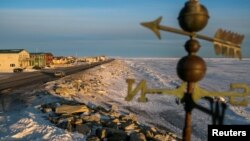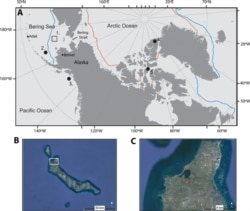Scientists are reporting that ice cover in the Bering Sea decreased during the winters of 2018 and 2019 to levels not seen in thousands of years. Reuters news agency says the new report adds to concerns about the effect of climate change in the Arctic.
The Bering Sea is in the northern Pacific Ocean, between Russia and the American state of Alaska.
The scientists said satellite images and records provide a clear picture of how the sea ice has changed over the past 40 years. Before that, the only ice records available were from those found in ship records and other observations.
So, scientists turned to peat land on Saint Matthew Island, off the coast of Alaska. Peat is plant tissue that breaks down in wet conditions. It can hold organic substances from plants that lived thousands of years ago.
The researchers studied different forms of oxygen molecules trapped in the peat land. With this information, they were able to estimate atmospheric and ocean conditions that would have affected rainfall and sea ice over a period of 5,500 years.
The researchers reported their findings in Science Advances, a publication of the American Association for the Advancement of Science.
St. Matthew “island in itself has acted as its own weather station,” said Matthew Wooller, one of the researchers. He likened the levels of soil in the peat to a “book going back in time.”
Wooler is director of the Alaska Stable Isotope Facility at the University of Alaska Fairbanks.
Many studies have shown that the Arctic has warmed in recent years. Sea ice levels in the area around the North Pole have decreased. This year, the summertime Arctic sea ice reached its lowest level for the month of July in 40 years of record keeping.
Sea ice builds up again each year during the winter. But the new study suggests that, in the Bering Sea, sea ice may also be decreasing during cold weather.
The loss of sea ice is already hurting Arctic wildlife, such as walruses, polar bears, and seals. The loss of sea ice also affects indigenous communities that depend on hunting for food and clothing.
Shrinking sea ice intensifies warming in the Arctic. That is because areas of dark water take the place of the sea ice. The dark water absorbs, or takes in, solar radiation instead of reflecting it back into the atmosphere.
“If we lose the sea ice you are completely changing the temperatures of the Arctic,” noted Julienne Stroeve, who was not involved in the study. She is a climatologist with the National Snow and Ice Data Center at the University of Boulder Colorado.
The study suggests that changes in the flow of ocean waters and atmospheric conditions linked to climate change have had a big effect. So says Miriam Jones, the lead writer of the study. She is a geologist with the U.S. Geological Survey.
“There’s a lot more going on than simply warming temperatures,” Jones said. “We’re seeing a shift in circulation patterns both in the ocean and the atmosphere,” she added.
In addition, the study suggests that changes in sea ice take place at least 20 or more years after changes in carbon dioxide and other heat-trapping gases.
Stroeve suggested that the study could have been strengthened with more comparisons to information gathered by ships and whaling expeditions dating back to the 1800s.
I’m Mario Ritter Jr.
Matthew Green reported this story for Reuters. Mario Ritter Jr. adapted it for VOA Learning English. George Grow was the editor.
_________________________________________
Words in This Story
indigenous – adj. produced, living or existing naturally in an area
reflecting – v. to strike a surface and go back in the opposite direction
circulation – n. the movement of air or water through an area
expedition – n. a trip undertaken by a group of people for a purpose
We want to hear from you. Write to us in the Comments section, and visit our Facebook page.









